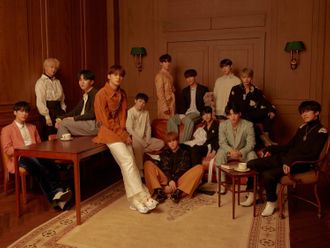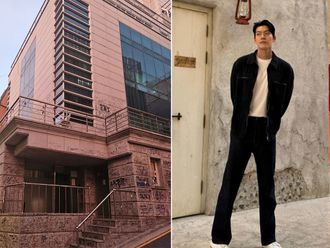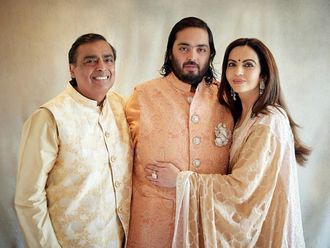
It was the perfect birthday bash for Anjolie Ela Menon, the celebrated Indian artist, who turned 70 on July 17. In a glittering hall in New Delhi, ricocheting with the laughter of friends and family, Menon's four grandchildren recited poetry for her. Filmmaker and friend Shyam Benegal launched the artist's biography spanning her career of five decades even as an exhibition featuring 70 works celebrated significant phases of Menon's life.
And what a life it has been. Brimming with art of luminescent beauty, textured with travels to exotic lands, tutelage under great masters, commercial and artistic gratification and a trove of friends and wellwishers. Indeed, in a career straddling half a century, the septuagenarian has carved a niche for herself in contemporary Indian art. Ever since her debut exhibition in 1958 at age 18 — where a young and effervescent Menon displayed a mind-boggling 53 works in myriad styles — her prolific output, command over numerous mediums and an extraordinary sensibility have won her plaudits. The artist's trademark oil-on-masonite paintings and mixed-media works continue to enchant connoisseurs in India and overseas.
Melancholic streak
Though Menon is synonymous with melancholic female nudes, her oeuvre spans several genres. In fact few contemporary Indian artists can boast a cachet of such diversity and depth. Art historian Sevanti Roy opines that despite her range, Menon's artistic trajectory can be clearly defined. "While her early work was characterised by a certain moodiness, profoundly influenced as it was by Romanesque and Byzantine art," says Roy, "her later work reflects a more sombre sensibility." As the painter herself accepted once: "My nature is somewhat melancholic. I think this is a very Bengali trait, where introspection and the dream-state inevitably result in the creation of music, painting and poetry which is deeply sombre."
By the 1970s Menon's work began to acquire a mythical quality. Her repertoire broadened to include allegorical goats, dogs, reptiles, crows and lizards as corollaries to her central characters, mostly diaphanously clad women.
As her recent 370-page biography Anjolie Ela Menon: Through the Patina, by art critic Isana Murty puts it: "At a time, when modernist abstraction is preferred by artists both in India and the West, Menon's works have been rigorously figurative, sensual and romantic."
Indeed the thread of romanticism runs prominently through the artist's work and personal life. Menon's student days in Europe, apparently, were spent in Florence in the Uffizi Galleries "completely bewitched" by the Botticellis and Giovanni Cimabue, and the works of other great Italian Renaissance painters. "That quality of subdued brilliance emerging from layers of glazes and the hard gloss of the surface," Menon recounted later, "the landscapes bathed in the greenish light of Sienna, were to influence my technique permanently."
The pronounced eclecticism in her work was perhaps inescapable given her roots and upbringing. Born in 1940 to mixed Bengali and American parentage, the painter studied at the JJ School of Arts in Mumbai followed by a scholarship stint at the Ecole des Beaux Arts in Paris in 1961-62 on a French government scholarship.
Since then, the world has been her oyster. She married her childhood sweetheart ex-Admiral Raja Menon and lived and worked in India, England, the US, Germany and the erstwhile USSR. She has had over 40 solo shows in India, America, Russia, Germany, France and England and several museums in India and abroad have bought her works.
Menon has represented India at the Algiers Biennale, the Sao Paulo Biennale and three triennales in New Delhi. She had been invited by the British Council, the United States State Department and the French Ministry of Culture to confer with leading artists in these countries. Menon has also served on the advisory committee and the art purchase committee of the National Gallery of Modern Art, New Delhi, where she was curator for a major exhibition of French Contemporary Art in 1996.
The artist was awarded the Padmashri — a national civilian honour — and is on the board of trustees of the Indira Gandhi National Centre for Arts. A book, Anjolie Ela Menon: Paintings in Private Collections, has been published on her life and work and films made on her for the Indian TV channel Doordarshan and CNN.
Yet, like a well-rounded artist, Menon has drawn from a groundswell of the personal and the familial to enrich her canvas. She once told a journalist how her "extremely joyous condition of motherhood produced a spate of Madonnas and Child".
Similarly, the window — a recurrent leitmotif in the artist's works — finds a resonance in her personal life too. Apparently, when her family was constructing a house in Bangalore in 1979, Menon bought two quaint windows from a junk shop. Before, she knew it, the window had crept into her work as an idiom, looking in on secret interiors or looking out to mysterious landscapes. Later, windows became a convenient grid for Menon to bifurcate her paintings, "often fragmenting an image and re-assembling it in a different order, thus creating surrealist juxtapositions".
Always experimenting and pushing the envelope, Menon has also delved into the austere precision of glass making. She made a series of trips to the Italian island of Murano, famous for its craftsmanship of stunning glass objects. She spent four years there, working with local artists to execute a large body of crystal sculptures, later showcased in two exhibitions — Sacred Prism 1 and Prism 11. The twin series of sculptures represented a departure from painting, not to mention the challenge of working with the third dimension which Menon found "immensely stimulating".
It was the same "stimulation" that led to the artist's foray into jewellery. Menon collaborated with a Mumbai-based jewellery house to create stunning pendants and lockets studded with precious stones between 2001 and 2006.
However, as often happens with most celebrated artists, controversy has dogged Menon too. In 2004, she had her assistant of 20 years, Hamid Safi, arrested for producing fakes of her paintings and then selling them clandestinely. Brazen in his defence, Safi claimed he completed most of the artist's works anyway.
The matter came to light when the Mumbai-based Gallery 7 accused Menon of having a hand in a fake painting sold in her name. The gallery claimed that one of Menon's works, Female Head, was actually the work of her assistant, who had admitted in a videotaped statement that he often completed Menon's paintings, which Menon then signed.
Menon refuted the charge, calling the statement as a "cover-up" operation by the gallery owners to camouflage the fact that they were selling a fake, and threatened to sue them.
Menon's life has indeed been as colourful as her canvases.
Neeta Lal is a freelance journalist based in New Delhi.




_resources1_16a30b3d57a_small.jpg)






